Module 5
Superconductivity
Content
- Effect of Magnetic Field
- Effect of Current
- Isotopic Mass Effect
- Pressure Effect
- Impurity Effect
It was first discovered by the Dutch physicist Heike KamerlinghOnnes, who was the first to liquefy helium (which boils at 4.2 Kelvin at standard pressure).
In 1911 KamerlinghOnnes and one of his assistants discovered the phenomenon of superconductivity while studying the resistance of metals at low temperatures. They studied mercury because very pure samples could easily be prepared by distillation. The historic measurement of superconductivity in mercury is shown in Figure.
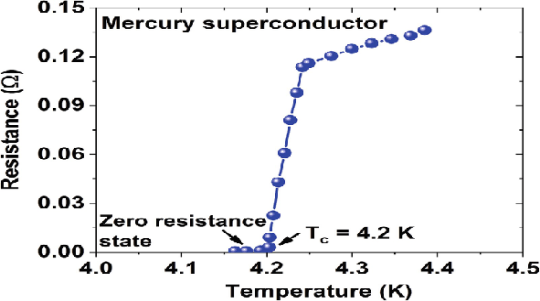
The electrical resistance of mercury decreased steadily upon cooling, but dropped suddenly at 4.2 K, and became undetectably small.
Transition Temperature or Critical Temperature Tc
The temperature at which electrical resistivity of the material suddenly drops to zero and the material changes from normal conductor to a superconductor is called the transition temperature or critical temperature Tc.
Soon after this discovery, many other elemental metals were found to exhibit zero resistance when their temperatures were lowered below a certain characteristic temperature of the material, called the critical temperature, Tc.
The ability of certain metals, their compounds and alloys to conduct electricity with zero resistance at very low temperature is called superconductivity. The materials which exhibit this property are called superconductors.
Properties
Following properties are shown by superconductors.
- It is a low temperature phenomenon.
- The electrical resistivity drops to zero.
- The conductivity becomes infinity.
- The transition temperature is different for different substances.
- Materialhaving high normal resistivity exhibit superconductivity.
- Materials for which ρZ= 106(where Z is a atomic number and ρis resistivity) show superconductivity.
- Superconductivity is very sharp for chemically pure and structurally perfect specimen.
- Ferro magnetic and Anti ferromagnetic materials are not superconductors.
- Below the transition temperature the magnetic flux lines are rejected out of the superconductors.
- Generally Superconducting elements lie in the inner columns of the periodic table.
- Those metallic elements having their valence electrons lies between 2 to 8 exhibit superconductivity.
- Below the transition temperature the specific heat curve is discontinuous.
- There is a discontinuous change in specific heat.
- There are small changes in volume and thermal conductivity of the material.
Imagine that both the ideal conductor and superconductor are above their critical temperature, Tc. That is, they both are in a normal conducting state and have electrical resistance.

Figure Effect of Magnetic Field to Superconductor
When magnetic field Ba is then applied. This results in the field penetrating both materials. Both samples are then cooled so that the ideal conductor now has zero resistance. It is found that the superconductor expels the magnetic field from inside it, while the ideal conductor maintains its interior field.
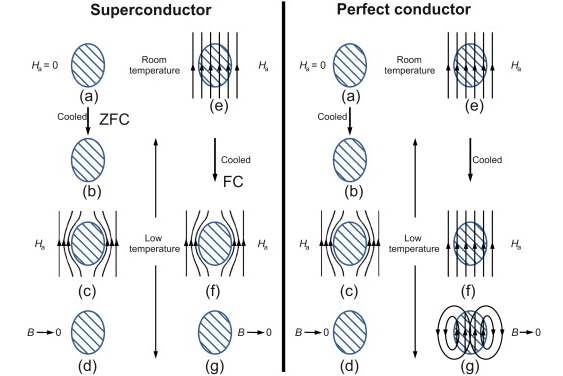
The above figure can also be used to understand the difference between ideal conductor and superconductor.
Note that energy is needed by the superconductor to expel the magnetic field. This energy comes from the exothermic superconducting transition. Switching off the field induces currents in the ideal conductor that prevent changes in the magnetic field inside it – by Lenz’s law. However, the superconductor returns to its initial state, i.e. no magnetic field inside or outside it
In 1933, Walter Meissner and Robert Ochsenfeld discovered a magnetic phenomenon that showed that superconductors are not just perfect conductors.
When a weak magnetic is applied to a superconducting specimen at a temperature below transition temperature Tc the magnetic flux lines are expelled. This phenomenon is called Meissner effect.
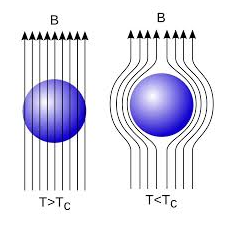
Under normal state the magnetic induction inside the specimen is
B = μ0(H+I)
Where H is the external applied magnetic field and I is the magnetization produced inside the specimen.
When the specimen is in superconducting state B=0 (Meissner effect)
B = μ0(H+I)
0 =μ0(H+I)
H= -I
χ = H/I =-1
Thus the material is act as a perfectly diamagnetic because for diamagnetic material susceptibility χ = -1.
Let us consider a superconducting material is in normal state. From ohms law, the electric field E=Jρ
On cooling the material to its transition temperature ρ tends to zero. If J is held finite E must be zero. From Maxwell’s equations
∇× E = - dB / dt
Under superconducting condition
Since E is zero
DB/dt =0
Or B=constant.
This means that the magnetic flux passing through the specimen should not change on cooling to the transition temperature. The Meissner effect contradicts the result.
Based on the diamagnetic response superconductors can be classified into two types, they are
1. Type I superconductors
2. Type II superconductors.
- Type I superconductors
Superconductors which one follows a complete Meissner effect is called type I superconductors. It is also known as soft superconductors.
When the magnetic field strength is gradually increased from its initial value H <HC atHCthe diamagnetism is abruptly disappear and the transition from superconducting state to normal state is sharp as shown in figure. These superconductors are known as soft superconductors.
Examples: - Al, Zn, Hg and Sn

Figure Type I superconductors
2. Type II superconductors
Superconductors which does not follow the complete Meissner effect is called type I superconductors. It is also known as hard superconductors.
In type II superconductors, the specimen is in pure superconducting state up to the field HC1 (lower critical field) when the field is increased beyondHC2(upper critical state) the magnetic flux lines start penetrating.
The specimen is in mixed state between HC1andHC2. AboveHC2, the specimen is in normal state. This means that the Meissner effect is incomplete in the region between HC1 andHC2. This region is known as vertex region. These superconductors are known as hard superconductors.
Examples: - Zr, Nb
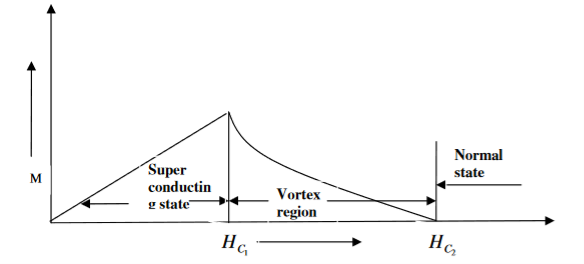
Figure Type II superconductors
Differences between type I and Type II superconductor
Type I superconductor | Type II superconductor |
1. It follows complete Meissner effect. | 1. It does not follow the complete Meissner effect |
2. It has single critical field valueHC | 2. It has two critical field values HC1 andHC2. |
3. There no mixed state. | 3. There is a mixed state |
4. They are soft superconductors | 4. They are hard superconductors |
5. Materials with pure form are type I superconductors | 5. Materials with impurities or alloys are type II superconductors |
Effect of magnetic field
Effect of Current
Isotopic effect
Pressure Effect
Impurity Effect
Effect of magnetic field
Superconductivity of a metal mainly depends on the temperature and strength of the magnetic field in which the metal is placed. Superconductivity disappears if the temperature of the specimen is raised above Tc or a strong enough magnetic field is applied. At temperatures below Tc, in the absence of magnetic field, the material is in superconducting state. When the strength of the magnetic field is applied to a critical value Hcthe superconductivity disappears.
The dependence of critical field upon the temperature is given by
HC(T) = HC(0) [ 1 – (T/TC)2]
Variation of HC w.r.t. TC
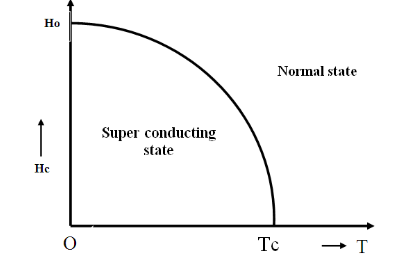
Effect of Current
An electric current is passing through the superconducting material itself may gives rise to necessary magnetic field. For example, when the current is passing a superconducting ring, it gives rise to its own magnetic field. As the current increases to critical valueIC, the associated magnetic field becomesHC and the superconductivity disappears.
IC = 2πrHC
Isotopic effect
In superconducting materials the transition temperature varies with the average isotopic mass of their constituents. The variation is found to be in general form
TC∝M−α
OrTCM−α= constant
Where α is the isotopic effect coefficient and is defined as
α =∂lnTC/∂ ln M
The value of α is approximately 0.5. For example, the average mass varies from 199.5 to 203.4 atomic mass units and accordingly the transition temperature varies from 4.185K to 4.146K.
Pressure Effect
Application of pressure brings about a change of transition temperature Tc usually Tcis raised with pressure. As Hc(T) is temperature- dependent, increased pressure is found to result in a slight change of Hc(T).
Unlike chemical substitution, pressure is a thermodynamic parameter which can be used to understand the phase transition as well as charge conduction mechanism without introducing disorder in the system.
Certain metal are found to exhibits superconductivity phenomenon on increasing the pressure over them.
For example cesiumis found to exhibits superconductivity phenomenon at Tc =1.5K on applying pressure 110Kbar.
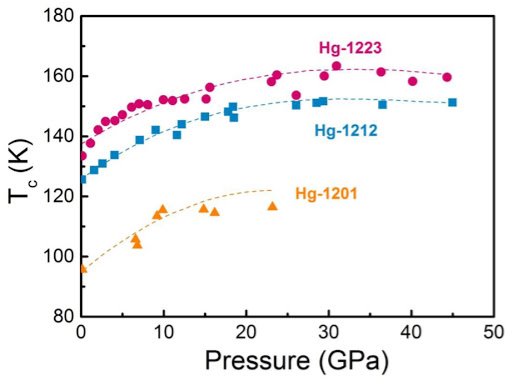
Figure: Showing variation of Pressure with Tc
Impurity Effect
Adding a foreign matter into pure specimen or its existence already makes the sample impure. Presence of impurities changes almost all properties of a super conductor, especially its magnetic behaviour.
However the superconducting properties is not lost by adding impurities to it but the value is lowered.
According to London’s equations, the magnetic flux does not suddenly drop to zero at the surface of the type I superconductor, but decreases exponentially. The penetration of magnetic field through one face of the superconductor is shown in figure.
According to Meissner effect the field inside the superconductor is zero, but in practice a small portion of field H0 or B0 penetrates a small distance into the superconductor.
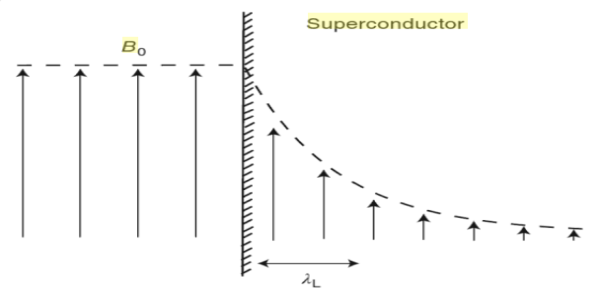
The penetration of field at a distance x form the face is given by
Where λ =penetration depth
When x= λ, then H = H0 /e
The penetration depth is the distance inside the superconductor at which the penetrating magnetic field is equal to 1/e times of the surface magnetic field H0. Generally λ ranges from 10 to 100 nm.
The penetration depth depends upon the temperature is given by the relation
λ (T) = λ (0) / [1 – T4/ T4C]1/2
Where λ (0) is the penetration depth at T=0K
Let us consider a thin insulation layer is sandwiched between the two superconductors in addition to normal tunneling of electrons, the super electrons tunnel through the insulation layer from one superconductor to another with dissociation, even at zero potential difference across the junction. Their wave functions on both sides are highly correlated. This is known as Josephson Effect.
D.C Josephson effect
According to Josephson when tunnelling across through the insulator it introduces a phase difference ϕ0 between the two parts of the function on opposite sides of the junction as shown in figure
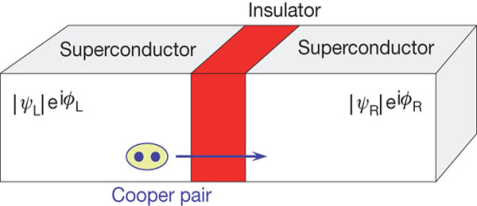
The tunnelling current is given by
I =I0Sin(ϕ0)
Where I0 is the maximum current that flows through the junction without any potential difference across the junction. This effect is called D.C Josephson effect.
Mathematical Analysis
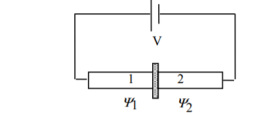
Figure Two superconductors separated by a thin insulator
Suppose we have two superconductors connected by a thin layer of insulating material as shown in figure. We define Ψ1 and Ψ2 as the quantum mechanical wavefunction of the superconducting state in the left and the right superconductor. The dynamics of the two wavefunctions are then determined by the following coupled Schrödinger equations:
iℏ = µ1Ψ1+KΨ2
= µ1Ψ1+KΨ2
iℏ = µ2Ψ2 +KΨ1 …….(1)
= µ2Ψ2 +KΨ1 …….(1)
Where K is constant representing the coupling across the barrier.
And µ1, µ2 are the lowest energy states on either side.
The wavefunctions can be written as
Ψ1= 
Ψ2 =  …….(2)
…….(2)
Where n1, n2 are the density of Cooper pairs and θ are the phases. Substituting equation (2) into equation (1) gives
ℏ  = -ℏ
= -ℏ  = 2K
= 2K  Sin(θ2-θ1) …….(3)
Sin(θ2-θ1) …….(3)
ℏ  (θ2-θ1) =µ2 - µ1 …….(4)
(θ2-θ1) =µ2 - µ1 …….(4)
The time derivative of the density of Cooper pairs describes a charge transport therefore I = ∂n1/∂t.
If a voltage V is applied between the junctions the energy levels will shift that is µ2−µ1 = 2eV .
Let I0 = 2K(n1n2) ½/ℏ andϕ0= θ1 – θ2then
I =I0 Sinϕ0 …….(5)
 =2eV /ℏ …….(6)
=2eV /ℏ …….(6)
Equations (5) and (6) provide the main results of Josephson junction theory. The current I is called a Josephson current or a super current. This strongly predicts non-linear current-voltage behavior.
From equation (5,6) it is clear that a DC current can be drawn through the junction without any voltage drop, as long as the DC current is smaller than I0.
The phase difference will adjust according to equation (5).
A.C Josephson effect
Let a static potential difference is applied across the junction, an additional phase is introduced by the cooper pairs during tunnelling across the junction. This additional phase change ∆ϕ at any time t can be calculated using quantum mechanics.

∆ϕ = Et /ℏ
Where E denotes the total energy of the system.
In present case E=2eV0
Hence
∆ϕ = 2eV0t /ℏ
The tunneling current can be written as
I =I0Sin(ϕ0+2eV0t /ℏ)
I =I0Sin(ϕ0+ωt)
Where ω = 2eV0/ℏ
This represents alternating current with angular frequencyω. This is A.C Josephson effect.
Current voltage characteristic of a junction is shown in figure.

When Vo = 0 there is a constant flow of dc current through the junction.
This current is called superconducting current and the effect is called Josephson effect.
When Vo<Vc, a constant dc current Ic flows.
When Vo>Vc, the junction has finite resistance, and the current oscillates with some frequency.
Applications of Josephson Effect
- Josephson effect is used to generate micro waves frequency with ω = 2eV0/ℏ
- A.C Josephson effect is used to define standard volt.
- A.C Josephson effect is used to measure very low temperatures based on the variation of frequency of the emitted radiation with temperature.
- A.C Josephson effect is used for switching of signals from one circuit to another.
BCS theory of superconductor was put forward by Bardeen, Cooper and Schrieffer in 1957 and hence named as BCS theory. This theory could explain the effects such as zero resistivity, Meissner effect, isotopic effect etc. Electron lattice interaction via lattice deformation.
Electron –phonon Interaction
BCS theory showed that the basic interaction responsible for superconductivity appears to be that of a pair of electrons by means of an interchange of virtual phonons. This is explained as follows:-
Suppose an electron approaches a positive ion core. It suffers attractive coulomb interaction. Due to this attraction ion core is set in motion and thus distorts that lattice. Let a second electron come in the way of distorted lattice and interaction between the two occurs which lowers the energy of the second electron. The two electrons therefore interact indirectly, via lattice distortion or the phonon field, thus lowering the energy of electrons. This type of interaction is called electron-lattice is quantized in terms of phonons the above interaction can also be interpreted as electron –electron interaction through phonons.
Let an electron of wave vector K emits phonon q, which is absorbed by an electron of wave number K.K is thus scattered as K-q and the process being a virtual one. The nature of the resulting electron-electron interactions depends on the relative magnitudes of the electronic energy change and the phonon energy. If this phonon energy exceeds electronic energy, the interaction is attractive.
Let us consider an electron is passing through the lattice positive ions. The electron is attracted by the neighbouring lattice positive ions as shown in figure 1. Due to the attraction of electron and ion core, the lattice gets deformed on scale. So electron get partially positive charge. Now if another electron passes by the side of assembly of said electron and ion core, it gets attracted towards the assembly.
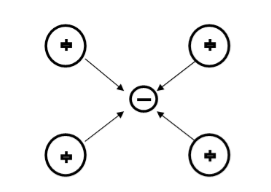
The second electron interacts with the first electron due to the exchange of virtual photon q, between two electrons. The interaction process can be written in terms the wave vector k as
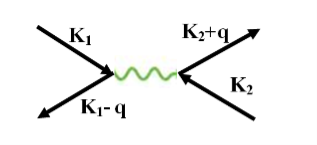
k1’ =k1–q k2’ = k2+q
These two electrons together form a cooper pair and is known as cooper electron.
Cooper pairs
To understand the mechanism of cooper pair formation, let us consider the distribution of electrons in metals as given by the Fermi-Dirac distribution function.
F(E) = 1/ 1+ e E-EF/kT
At T= 0K, all the Fermi energy states below the Fermi level are completely filled and all the states above are completely empty. Let us see what happens when two electrons are added to a metal at absolute zero. Since all the quantum statesE<EF, are filled, they are forced to occupy states havingE>EF.
Cooper showed that if there an attraction between the two electrons, they are able to form a bound state so that their total energy is less than 2EF. These two electrons are paired to form a single system. These two electrons form a cooper pair and is known as cooper electron.
Coherence length
The paired electrons are not scattered and can maintain their coupled motion up to certain distance called the coherence length. It is a measure of the distance within which the gap parameter does not change very much in varying magnetic field.
- Superconductors form the basis of energy saving power systems, namely the superconducting generators, which are smaller in size and weight, in comparison with conventional generators.
- Superconducting magnets have been used to levitate trains above its rails. They can be driven at high speed with minimal expenditure of energy.
- Superconducting magnetic propulsion systems may be used to launch satellites into orbits directly from the earth without the use of rockets.
- High-efficiency ore-separating machines may be built using superconducting magnets which can be used to separate tumour cells from healthy cells by high gradient magnetic separation method.
- Since the current in a superconducting wire can flow without any change in magnitude, it can be used for transmission lines.
- Superconductors can be used as memory or storage elements in computers.